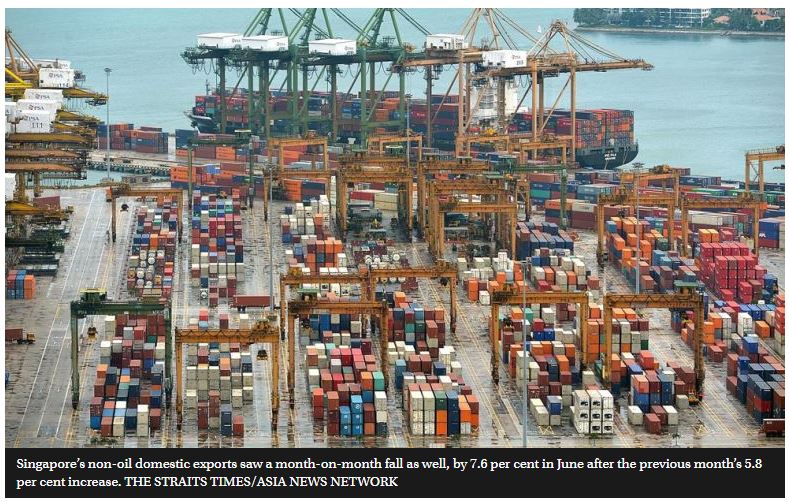Singapore exports plunge 17.3% for largest drop in six years
Singapore’s exports fell by double digits for the fourth straight month, with shipments in the key electronics sector sinking by nearly a third.
Non-oil domestic exports (Nodx) performed worse than expected, slumping 17.3 per cent in June compared to a year ago, following a downwardly revised 16.3 per cent fall in May, said Enterprise Singapore on Wednesday.
This is the biggest year-on-year drop since shipments sank 33.2 per cent in February 2013.
It is also sharply below analysts’ expectations of a 9.6 per cent drop, according to a consensus of forecasts in a Bloomberg poll.
CIMB Private Banking economist Song Seng Wun noted it was last week’s flash figures for Singapore’s second-quarter growth – which came in almost flat at 0.1 per cent – which signalled that both trade and manufacturing numbers were going to be markedly worse than expected in June.
DBS senior economist Irvin Seah said: “It’s that familiar sinking feeling again.”
“The recent set of bad data has dashed any hope of a recovery in the second half of this year,” he said, adding that typically, figures stabilise by the middle of the year.
“But instead we see further decline, and the pace of decline has also accelerated,” he added. “What we can hope for in a best-case scenario is for the numbers to start to stabilise towards the fourth quarter.”
While he expects the economic slowdown this time to be more severe than in the period from 2013 to 2015, he noted the current situation is not yet near what was seen in the global financial crisis around a decade ago.
He foresees a challenging outlook for workers, with retrenchments likely to rise and job vacancies to decline.
Companies will also need to consider new sources of growth and it is time for the government’s monetary and fiscal policies to turn accommodative, he said.
The dismal exports and second-quarter growth data raises the prospect of a monetary policy easing later this year, said analysts.
Maybank Kim Eng economists Chua Hak Bin and Lee Ju Ye said in a report that given the current recession risk and softer core inflation, they expect the Monetary Authority of Singapore to ease the appreciation slope of the Singapore dollar in October, to a neutral bias or zero appreciation. Currently, it is on a modest and gradual appreciation stance.
Wednesday’s exports report showed electronic shipments plunged by 31.9 per cent last month, extending a 31.6 per cent drop the month before – dragged by shipments of integrated circuits, personal computers and disk media products.
Song added: “Within the chip segment, we have already seen many downbeat assessments from chipmakers, equipment makers, cutting their sales forecast for the first time in four years.”
“The ongoing squabble between South Korea and Japan does not help matters either,” he added, referring to Japan restricting exports of critical materials used by South Korean chip manufacturers.
‘South Korea, Taiwan suffering too’
ING economist for Asia Prakash Sakpal noted that semiconductors are a key segment for Singapore. Electronic products account for about 25 per cent of Nodx, almost half of which are made up of semiconductors, he said.
But he added that the poor performance by exports last month does not just affect Singapore. “South Korea and Taiwan are suffering from this as well, although Singapore seems to be hit a bit more than these other economies.”
For non-electronic products, Nodx dropped 12.4 per cent, down from 11.1 per cent the month before, mainly due to shipments in non-monetary gold, petrochemicals and pharmaceuticals.
Overall Nodx saw a month-on-month fall, by 7.6 per cent in June, after the previous month’s 5.8 per cent increase.
Weighing on the export outlook are trade tensions between the US and China, weaker external demand and a fading semiconductor cycle.
Even as trade talks have resumed behind the scenes after US President Donald Trump met Chinese President Xi Jinping at the Group of 20 summit last month, tensions simmer.
The US continues to apply pressure on China, with President Trump looking to increase the US domestic content threshold for iron and steel in federal procurements.
Meanwhile, China’s economic growth slowed to 6.2 per cent in the second quarter, its weakest pace in at least 27 years.
Exports to all of Singapore’s top 10 markets fell as well, except to the US. Leading the decline were falling shipments to Hong Kong, China and Europe.
Sakpal of ING said: “Despite the trade war, shipments to the US continue to be very strong . . . Perhaps it is the underlying strength of the US economy. We have already seen from overnight data that retail sales in the US were surprisingly strong.”
On a seasonally-adjusted basis, the level of Nodx was $12.9 billion in June, lower than the previous month’s $14 billion.
On a year-on-year basis, total trade decreased by 7.2 per cent, and non-oil re-exports declined by 2.8 per cent, after a five per cent rise in May. THE STRAITS TIMES/ASIA NEWS NETWORK


 English
English




